Search Results for Tag: wwf
WWF: We just halved the world’s vertebrate population
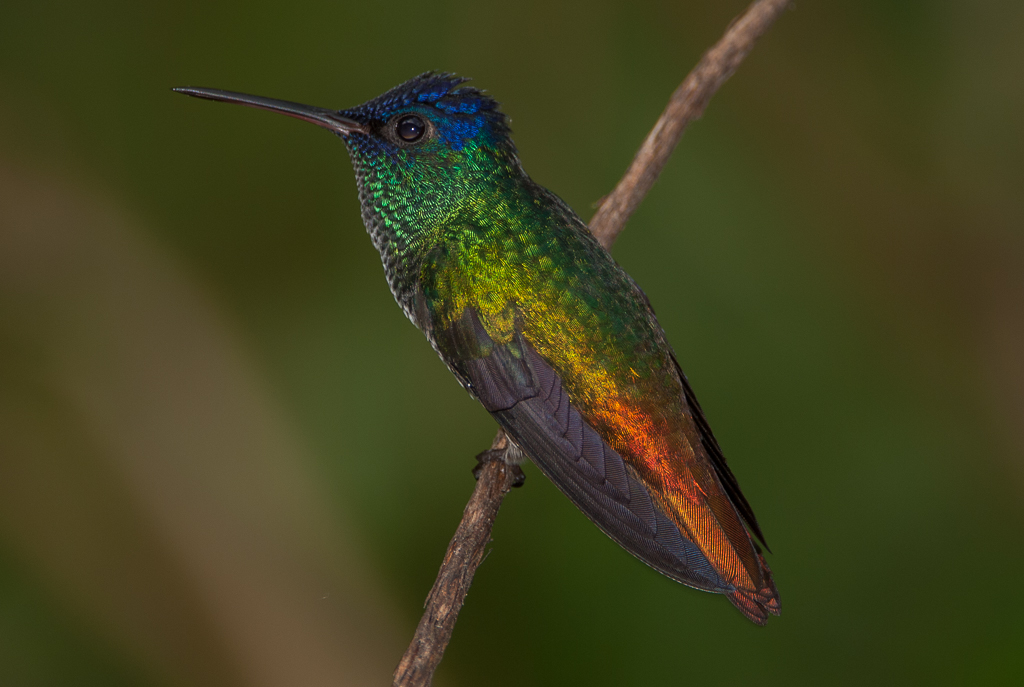
It’s not only the world’s population of
birds that has dropped massively over the last 40 years. Photo: Rob Williams
Humankind needs to rethink its way of living and consuming the world’s resources immediately. That’s the bottom line of the latest Living Planet Index, presented by the World Wildlife Fund today in Berlin. Over just four decades we managed to reduce the size of the world’s populations of fish, birds, mammals, amphibians and reptiles by 52 percent. That’s a lot faster than previously thought, according to the WWF.
The report that is published every two years also says that our demands at the moment are 50 percent above what nature can bear. We cut down too many trees, use too much fresh water and emit carbon dioxide at an unsustainable rate.
The biggest declines of vertebrate wildlife was found in tropical regions, especially Latin America, the report finds. The dramatic numbers result from a change in the available information that went into the report. Two years ago the WWF talked about a decline of 28 percent in the time period from the 1970s until 2008, because the report relied on readily available information mostly from North America and Europe. Today the Living Planet Index is based on trends from around the world in a total of 10,380 populations of 3,038 mammal, bird, reptile, amphibian and fish species.
The main reasons for the massive decline are clear, states the report: the loss of natural habitats, overexploitation through hunting or fishing and climate change.
However, WWF International Director General Marco Lambertini strikes a hopeful note: it’s not too late to “develop sustainably and create a future where people can live and prosper in harmony with nature.”
Young climate enthusiasts sharpen skills at ‘2° Campus’
For the past two years, the German chapter of the World Fund for Nature (WWF) has organized a project called “2° Campus” or “Two degrees Celsius Campus.” It’s targeted at young students in Germany between the ages of 15 and 19.
The aim is to bring together young people interested in climate issues and science and encourage them to work on related subjects ranging from energy, mobility, building insulation to food. As part of the project, the students visited German universities, spoke with scientists and even got the chance to work on research projects with them.
As the project drew to a close this week in Berlin, Global Ideas reporter Julia Henrichmann caught up with some of the young climate enthusiasts and found out what drives them to engage with climate and environmental issues.
Enno Gerhard, 16, from Bremen
Global Ideas: What made you take part in the project?
I happened to read about it in a newsletter. I believe that if we don’t change the world, our future generations will not survive.
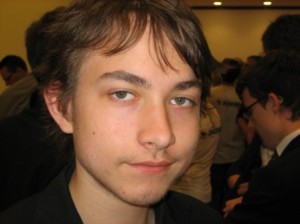 What was your focus during the project?
What was your focus during the project?
I always wanted to find out more about solar modules. We tried to figure out how to build organic solar cells. In the project, I was responsible for researching the variation of different temperatures in solar cells.
Has the 2° Campus project changed you as a person?
After taking part in the 2° Campus, I stopped eating meat, we even changed our electricity supplier at home. Now I would love to study physics to help build smart grids in Germany and to find new solutions for the power network (especially for alternative forms of energy).
What do you think are the most pressing climate issues?
We absolutely have to find quick answers for mobility, for example with electric cars. We also have to ensure that issues such as mobility and energy are brought together such as setting up new smart grids or building energy efficient buildings.
Lukas Jochum, 17, from Ottweiler in Saarland
Global Ideas: What got you interested in the project?
My teacher read about the project and asked me if I wanted to be part of it. I always wanted to save the earth and I’m already active in the Green Party.
What did you work on in the project?
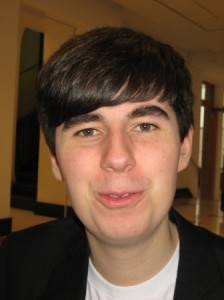 We worked on refitting old school buildings. For example, we looked at new ways of insulating buildings by installing new windows.
We worked on refitting old school buildings. For example, we looked at new ways of insulating buildings by installing new windows.
What do you do personally to reduce your carbon footprint?
I always use my bicycle, I am vegetarian and I’m trying to convince my parents not to use the car that often.
How do you see the state of the planet in 30 years?
My dream is that we ban nuclear energy worldwide.
Antonia Bürke, 17, from Leipzig
Global Ideas: What’s your motivation for participating in the project?
Climate change concerns us all.
What did you work on in the project?
In the project, I was responsible for inventing new coloring for solar cells. We used natural colors from tea, for example. It worked pretty well!
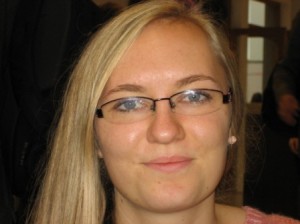 What do you do to combat climate change?
What do you do to combat climate change?
I don’t eat meat, I always use my bicycle or use public transport. And I try and convince my friends to do that as well.
Where do you see the world in 30 years?
My dream is that many more people use trains and buses instead of cars. But for that, public transport options need to be more attractive. I hope that the famous German “Energiewende” (the transition from nuclear and fossil fuels to renewable sources of energy) will be in force and implemented by other countries as well.
Helen Jerg, 16, from Mannheim
Global Ideas: What prompted you to apply for the project?
We are going to be here for a long time and if we don’t change our planet, then our future is uncertain.
What was your role in the project?
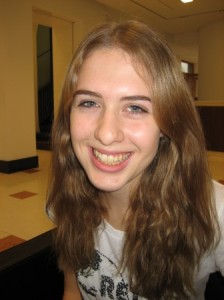 I want to study construction engineering to learn how to upgrade old buildings. My idea in the WWF project was not only to refit buildings and to put in new windows and to insulate walls but also to find a different use for school buildings. For example, why don’t we use existing school buildings and convert them into youth hostels over the holidays? That way no extra energy is wasted and the school buildings, that lie idle over the holiday period, are put to good use.
I want to study construction engineering to learn how to upgrade old buildings. My idea in the WWF project was not only to refit buildings and to put in new windows and to insulate walls but also to find a different use for school buildings. For example, why don’t we use existing school buildings and convert them into youth hostels over the holidays? That way no extra energy is wasted and the school buildings, that lie idle over the holiday period, are put to good use.
What’s your personal contribution to lowering emissions?
I am vegetarian and I try to convince my friends and family not to eat that much meat anymore. I also try to use organic products as much as I can.
What do you think the world will look like in 2043?
I hope that everybody will use green energy then, that many people turn vegetarian and that a critical mass of people become aware of the dangers of climate change.
Note: The name “2 degrees Celsius Campus” refers to a WWF study that shows greenhouse gas emissions in Germany can be cut by 95 percent by 2050 in order to limit global warming to a maximum of 2 degrees Celsius compared to pre-industrial levels. The study contains concrete suggestions for what needs to change in the fields of energy, mobility, housing and food in order to slash emissions.
All routes headed for Frankfurt
This is the third guest post as part of our series accompanying the WWF Youth Bike Tour this summer. Still having sore muscles from the previous day’s leg Tamara Nausner and her fellow cyclists lost little time to ride on to Frankfurt. It was the last stretch for our guest blogger.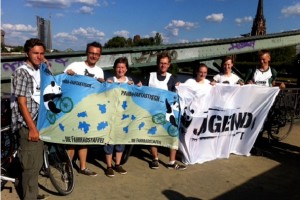
Today is a very special day. The bike tour really are two – one that traverses the country passing through the Eastern states, the other following a route in the West. But both will be merging at the end of today’s stretch. Filled with anticipation we are riding out of Wiesbaden, although our bodies hurt quite a bit. But: no pain, no gain. And after a while I get used to it and can enjoy the journey again along the river Main. I like the route more than the one yesterday because for the most part there is no road and no cars. At one point we even have an abandoned motorway all to ourselves. Some of us are cycling as fast as they can. We are all having fun.
We arrive at Frankfurt quite early. The riders from the Eastern route inform us that they will not be here for another few hours. To pass the time we treat ourselves to ice-cream, play cards and relax in the grass near the Main. Eventually the others arrive. Together we take a picture of the banners of the two teams now united.
For me and some of the others the bicycle relay is over now but the rest will ride on in the spirit of climate-friendly travel. I am so glad I took part and hope that there will be another tour next year. And I also hope that we could help encourage people to think about what they can do to protect our environment.
56 Kilometers turn strangers into friends
This is the second guest post as part of our series accompanying the WWF Youth Bike Tour this summer. Today Tamara Nausner tells us about her day on the road – and that 56 kilometers on a bike need not be the most taxing thing in a day of cycling…
My day starts very early in the morning. Too early. But today there is no time to be tired or lazy. So I’m packing all my luggage onto my bike and ride to the train station. It is so quiet and peaceful at this time in the morning.
Being a little late, my train eventually is on its way to Oberwesel – the starting point for today’s stage of the WWF Youth cycling tour.
What I learn along my journey is that there are no elevators at small stations, so I have to carry my bike up and down the stairs quite a few times. Not that easy with all the luggage.
At half past nine I arrive in the town, which is is located some 80 kilometers West of Frankfurt. I am very excited to meet the two cyclists, who will join me for the tour. And they don’t keep me waiting. I spot them immediately – they are wearing the vests carrying the WWF logo. Then they hand me one, too. Time for a picture of all of us! There is not much around; we eventually opt for an old ruin as a backdrop for our photo.
At last we start day 20 of our tour, which today will bring us to the city of Wiesbaden. But we are not the only ones on the road, framed by vineyards on one side and the river Rhine on the other. Unfortunately there are cars too. So after a while we decide to take a route through the vineyards. There are no other cyclists and no cars. Only a tractor. But very quickly we regret this idea because our path is steeply rising. Eventually we return to our previous route.
The weather is perfect: warm but not too hot, clouds and the sun take it in turns. We enjoy the journey. While riding we get to talk a bit, about everything, and I realize how nice it is to talk to people who have similar interests – protecting the environment being a very big one.
Our destination is getting closer. But before starting off on the final stretch we decide to take a break and have some lunch. That is when I notice for the first time just how tired I am. The rest of the trip is quite tough. Finally we arrive at the train station of Wiesbaden. But even after 56 kilometers on the bike there is no rest for us yet. A photographer is welcoming us, asks for our names and wants to take a couple of pictures. Then, he leaves.
A final short ride along a coarse gravel path to our night quarters turns out to be almost the hardest part of our journey today. But eventually we get there.
The next morning at 10am we are ready for the next leg of our tour. We take a picture and are on our way – to Frankfurt.
From gray to green – biking through Germany’s former industrial heartland
In the second part of our bike blog, Maurice Jurke, who’s part of the WWF’s bike tour across Germany, takes up the story as he encounters some strenuous uphill stretches (the good thing about those, as he points out, is rolling down), sweats it out in the summer heat and cycles through Germany’s former coal-fired industrial heartland which has now been rejuvenated into a green area.
It’s 3:20 pm and I am sitting in a small café in the inner city of Hamm in the western German state of North-Rhine Westphalia. It’s quite well known in Germany and so I expected a big town with and a landscape dominated by the color gray. But as so often this year, I was wrong. Instead, I cycled on a wonderful route from Gütersloh to Hamm.
During the day, I barely rode on streets since a large part of the stretch wound through fields and large forests. I began at 10:15 as usual and I had hoped to arrive after 60 kilometers and 3 1/2 hours. But again I was proven wrong. Literally. I took some wrong turns, and so I had to ride 70 kilometers over several mountains, and arrived after 4 hours. Still a good number, but I was not very happy with my day. It was too hot and I am really thankful for my ice cream and my ice-cooled coke which I’m sipping at the moment. Still, it was a good day, it just could have been better. Well, I hope you had a perfect day. Me? I’m going to take a bath to cool down some more.
Let’ s go gray…uhh I mean green
Another day of biking through Germany and the direction is still south-west. From Hamm, we passed Dortmund and Duisburg, and now we’re visiting Langengeld, a small village at the border of Düsseldorf.
In the last three days, we’ve cycled past plenty of places in Germany’s old industrial heartland in the west. It’s called the Rhein- and Ruhrgebiet in German. There you’ll find big industrial companies and lots of mines and old coal pits. As Germany tries to change its energy policy, increasingly moving away from fossil fuels and towards renewable energy, coal is no longer a big player.
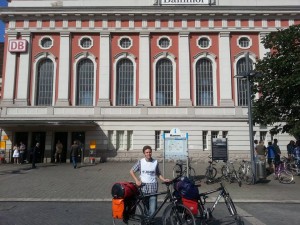 So you’ll find many old, abandoned and derelict coal mines. In some of these places, city authorities are trying to transform them into old people’s homes. Once gray and polluting, these unpopular mines are being upcycled and are a jewel in the inner cities.
So you’ll find many old, abandoned and derelict coal mines. In some of these places, city authorities are trying to transform them into old people’s homes. Once gray and polluting, these unpopular mines are being upcycled and are a jewel in the inner cities.
That means almost our entire bike route now goes through parks or forests, occasionally cut by some highways or an inner city. Germany, in this regard, has developed well, we think.
And here’s a personal question: what do you think of this development in Germany’s former industrial areas? Have the cities been successful? Would you want to live in this former gray area, which has now painted itself in green?




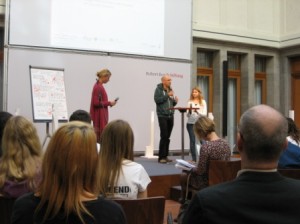

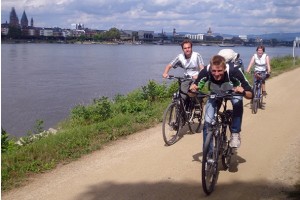
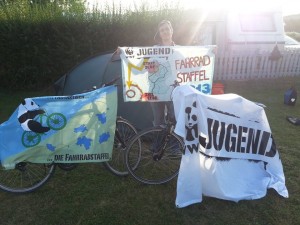




Feedback